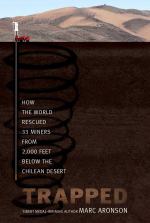|
This section contains 487 words (approx. 2 pages at 400 words per page) |

|
Trapped Summary & Study Guide Description
Trapped Summary & Study Guide includes comprehensive information and analysis to help you understand the book. This study guide contains the following sections:
This detailed literature summary also contains Topics for Discussion on Trapped by Marc Aronson.
The following version of the book was used to create this study guide: Aronson, Marc. Trapped. Simon and Schuster, New York, NY, 10020. 2011. Kindle AZW file.
In early August 2010, work was going on as usual in the San Jose mine in Chile. Then, a cave-in trapped 33 men more than 2,000 feet below the surface. Author Marc Aronson wrote about the cave-in and the rescue efforts, but he began his story with an overview of the geological facts that contributed to the situation in Chile. Aronson noted that mining has been going on for centuries. There are modern-day regulations in place that should provide some protection, including a requirement for alternative escape tunnels in case a cave-in cuts off the main mine's access. There were no escape tunnels at San Jose. Some of the men had expressed worry about the working conditions, and one had been urged to quit. Many families in the region struggled to get by. At least, some of the miners felt they had no choice but to continue to work in the mines.
As the hours turned into days, mine officials and government officials tried to figure out a way to rescue the trapped men. Families and friends gathered near the site, hoping for good news. Though some wanted to begin clearing rubble from the main access tunnel, officials feared the process would cause another cave-in. Officials soon approved three very different drilling machines, each manned with a team of highly-skilled professionals. They all wanted to reach the miners.
While the rescue efforts were going on above ground, the trapped miners were working to better their chances of survival. The shift foreman broke them into groups with specific tasks. The men gathered in an area designated as a shelter for a disaster like this. There was a small amount of food which the men rationed carefully, knowing they could be trapped for a long time. Finally, a drill bit broke through the ceiling of the shelter. The men tapped on the bit to alert those above ground of their presence. They painted the bit bright red and attached a couple of notes. After this moment, the rescuers were able to drill down with additional bits, then a small tube could be used to lower supplies to the men. Over the coming weeks, the men received letters from loved ones, medical supplies, food, and gifts, including games and magazines. Knowing it was going to take weeks to make a hole big enough for a man to pass through, the men established a new life below ground while families and rescuers settled into a new life on the surface. Finally, more than two months after the cave-in, the 33 men were brought to the surface. Aronson wrote that many people pitched in to help with the rescue effort. Moreover, all people could help on a daily basis by reducing their consumption of those minerals that are mined.
Read more from the Study Guide
|
This section contains 487 words (approx. 2 pages at 400 words per page) |

|



